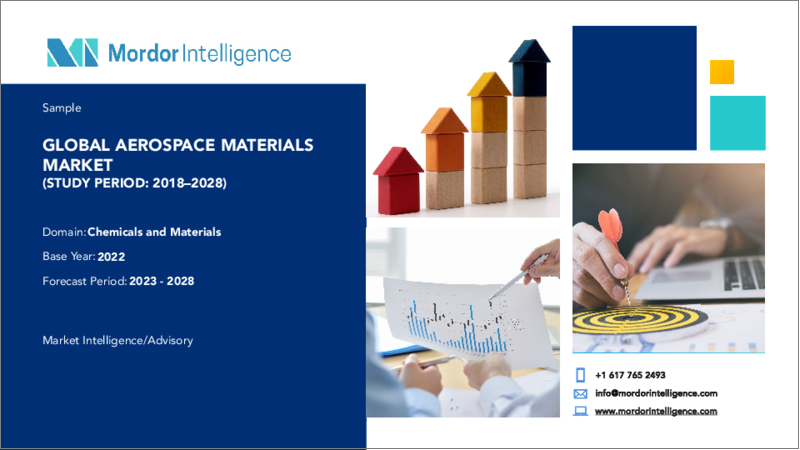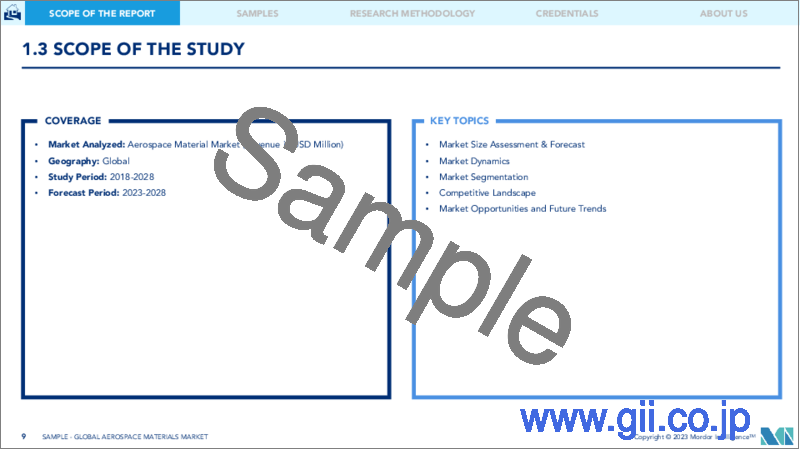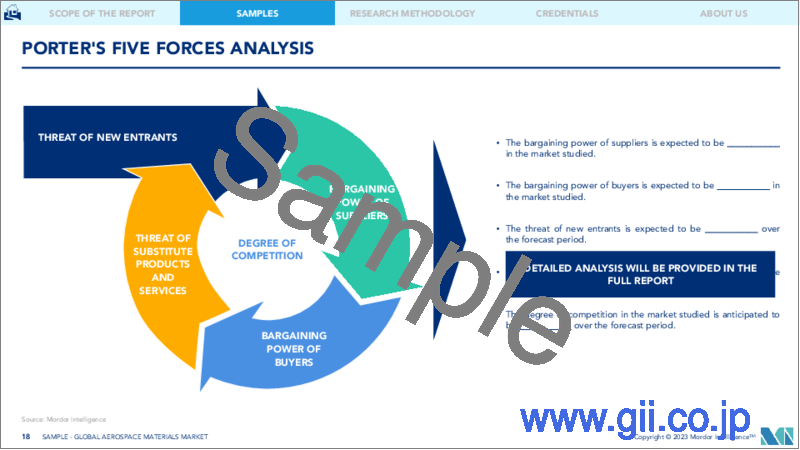|
|
市場調査レポート
商品コード
1195597
航空宇宙材料市場- 成長、動向、予測(2023年~2028年)Aerospace Materials Market - Growth, Trends, and Forecasts (2023 - 2028) |
||||||
|
● お客様のご希望に応じて、既存データの加工や未掲載情報(例:国別セグメント)の追加などの対応が可能です。 詳細はお問い合わせください。 |
|||||||
| 航空宇宙材料市場- 成長、動向、予測(2023年~2028年) |
|
出版日: 2023年01月23日
発行: Mordor Intelligence
ページ情報: 英文 300 Pages
納期: 2~3営業日
|
- 全表示
- 概要
- 目次
航空宇宙材料市場は、今年末までに442億米ドル以上に達すると推定され、予測期間中に8%以上のCAGRで推移すると予測されています。
COVID-19は、2020年の市場にマイナスの影響を及ぼしました。パンデミックとウイルスの蔓延を抑制するために課されたロックダウンのため、旅客航空便の施設が一時的に閉鎖されたのです。しかし、市場は2021年に大きな成長を見せ、2022年も成長を続けています。
主なハイライト
- 中期的には、航空機製造における複合材料の使用量の増加、宇宙産業の成長、米国および欧州諸国における防衛に関する政府支出の増加が、市場の成長を牽引すると予測されます。
- その反面、炭素繊維の製造コストの高さや合金の使用量の減少が、予測期間中に対象産業の成長を抑制する主要因となると予想されます。
- カーボンナノチューブやナノ添加剤とエポキシ接着剤の併用は、今後数年間で市場に機会をもたらすと思われます。
- 北米地域は、民間航空機の高い需要、軍事費における政府支援の増加、宇宙船セグメントにおける機会拡大により、市場を独占すると予想されます。
航空宇宙材料の市場動向
一般・民間航空機の需要拡大
- 一般・民間航空機は、民間航空(民間・民間)、旅客・貨物輸送など、さまざまな用途で使用されています。
- 航空宇宙産業は、旅客機需要の強化により成長が鈍化しています。また、新規航空機の受注残やビジネス航空機の復調は、航空宇宙産業の成長にさらに拍車をかける可能性があります。
- 世界の富裕層や超富裕層の増加に伴い、プライベート旅行の需要が高まり、ヘリコプターや客室の内装を改良したビジネスジェット機の調達が進んでいます。
- IATA(国際航空運送協会)によると、コビット中の2020年の世界の航空輸送量の年間成長率は約66%減少しました。2021年はプラス成長で約18%、2022年の予測では前年比51%の成長率を見込んでいます。
- 米国は世界最大の航空宇宙産業を有しています。連邦航空局(FAA)によると、同国の商業用航空機の数は2020年に5,882機を占め、2019年の7,628機と比較して22.9%の減少率を示しています。さらに、商業用航空機は2041年には8,756機まで増加し、CAGRは2%になると予測されています。さらに、米国の主要航空会社全体では、2019年の4,388機に対し、2020年には3,181機となり、約27.5%の減少率を記録し、2041年には5,101機となる見通しです。
- IBEF(インド・ブランド・エクイティ財団)とIATAの予測によると、インドの航空市場は2024年までに世界第3位になると予想されています。航空分野では、2021年に様々な投資や開発が行われました。例えば、2021年10月、Tata Sonsは国営航空会社Air Indiaの100%株式取得のために18,000カロールインドルピー(または24億米ドル)を提供し、同航空会社の買収を落札しています。
北米が市場を席巻する
- 北米地域は、米国やカナダといった国々からの需要増加により、市場を独占すると予想されています。
- 米国は北米最大の航空市場を有し、航空機の保有台数も世界有数です。フランス、中国、ドイツなどの国への航空宇宙部品の輸出が好調で、米国での堅調な個人消費とともに、航空宇宙産業の製造活動を促進しており、同国の航空宇宙材料市場に好機が誘発されると予想されます。
- 2022年の国防予算において、米国政府は国防計画に7682億米ドルを認め、バイデン政権の当初の予算要求から約2%増加し、この分野での航空宇宙材料の使用量が増加していることを記録しています。
- さらに、この業界における契約や協定は、民間および防衛用航空機の製造活動を刺激しています。例えば、2022年8月、ボーイング社は、KC-46A空軍生産ロット8の航空機、サブスクリプション、ライセンスに関する契約の修正(P00215)を獲得しました。これには、15機のKC-46A航空機の追加数量が含まれています。この契約は、イスラエルへの100%対外軍事販売で、金額はUSD 886,242,124です。
- カナダ航空宇宙産業協会(AIAC)によると、航空宇宙部門の年間売上高は310億カナダドル(約230億米ドル)です。カナダの航空宇宙産業の約80%は民間向けで、20%は軍事向けとなっています。
- モントリオールは、シアトル(ワシントン州)、トゥールーズ(フランス)に次いで世界第3位の航空宇宙産業の中心地です。航空宇宙は、イノベーション関連投資においてカナダの製造業をリードしており、研究開発活動への支出は年間14億米ドルを超えています。
航空宇宙材料市場の競合他社分析
世界の航空宇宙材料市場は、部分的に統合された性質を持っています。市場の主要プレイヤー(順不同)には、BASF SE、東レ株式会社、Hexcel Corporation、Solvay、Hunstman International LLCが含まれます。
その他の特典
- エクセル形式の市場予測(ME)シート
- アナリストによる3ヶ月間のサポート
目次
第1章 イントロダクション
- 調査の前提条件
- 調査範囲
第2章 調査手法
第3章 エグゼクティブサマリー
第4章 市場力学
- 促進要因
- 航空機製造における複合材使用の増加
- 宇宙産業の成長
- 米国および欧州諸国における国防費の増加
- 抑制要因
- 炭素繊維の高い製造コスト
- 合金の使用量減少
- 業界バリューチェーン分析
- ポーターのファイブフォース分析
- 供給企業の交渉力
- 買い手の交渉力
- 新規参入業者の脅威
- 代替品の脅威
- 競合の度合い
第5章 市場セグメンテーション(金額ベースの市場規模)
- タイプ
- 構造用
- コンポジット
- ガラス繊維
- 炭素繊維
- アラミド繊維
- その他の複合材料
- プラスチック
- 合金
- チタン
- アルミニウム
- 鉄鋼
- スーパー
- マグネシウム
- その他の合金
- 非構造部材
- コーティング剤
- 接着剤・シーラント
- エポキシ樹脂
- ポリウレタン
- シリコーン
- その他の接着剤・シーラント
- 発泡体
- ポリエチレン
- ポリウレタン
- その他の発泡体
- シール
- 構造用
- 航空機の種類
- 一般・商用
- 軍用・防衛
- 宇宙機
- 地域別
- アジア太平洋地域
- 中国
- インド
- 日本
- 韓国
- その他アジア太平洋地域
- 北米
- 米国
- カナダ
- メキシコ
- 欧州
- ドイツ
- 英国
- フランス
- イタリア
- スペイン
- ロシア
- その他の欧州地域
- 世界のその他の地域
- 南米
- 中東
- アジア太平洋地域
第6章 競合情勢
- M&A、ジョイントベンチャー、コラボレーション、契約
- 市場ランキング分析
- 主要プレイヤーの戦略
- 企業プロファイル
- 3M
- Acerinox SA(VDM Metals)
- Akzo Nobel NV
- Aluminum Corporation of China Limited(Chalco)
- Arkema
- ATI
- Axalta Coating Systems
- BASF SE
- Beacon Adhesives Inc.
- Carpenter Technology Corporation
- Corporation VSMPO-AVISMA
- DELO Industrie Klebstoffe GmbH & Co. KGaA
- Evonik Industries AG
- Greiner AG
- Henkel AG & Co. KGaA
- Hentzen Coatings Inc
- Hexcel Corporation
- Howmet Aerospace
- Huntsman International LLC
- HYOSUNG
- ISOVOLTA AG
- Jiangsu Hengshen Co. Ltd
- Mankiewicz Gebr & Co.
- Mitsubishi Chemical Corporation
- Nanjing Yunhai Special Metal Co. Ltd
- NIPPON STEEL CORPORATION
- PPG Industries Inc.
- Precision Castparts Corp.
- Reliance Industries Ltd
- Rogers Corporation
- SGL Carbon
- Socomore
- Solvay
- Tata Steel(Corus)
- The Sherwin-Williams Company
- Toray Industries Inc.
第7章 市場機会と将来動向
- エポキシ系接着剤によるカーボンナノチューブとナノ添加物の利用
The Aerospace Materials Market is estimated to reach over USD 44,200 million by the end of this year and is projected to register a CAGR of over 8% during the forecast period.
COVID-19 negatively impacted the market in 2020. Passenger air travel facilities were temporarily shut down because of the pandemic and the lockdowns imposed to curb the spread of the virus. However, the market showed significant growth in 2021 and is continuing to grow in 2022.
Key Highlights
- Over the medium term, the increasing usage of composites in aircraft manufacturing, the growing space industry, and increasing government spending on defense in the United States and European countries are expected to drive the market's growth.
- On the flip side, the high manufacturing cost of carbon fibers and the declining usage of alloys are the key factors anticipated to restrain the growth of the target industry over the forecast period.
- The use of carbon nanotubes and nano-additives with epoxy adhesives is likely to create opportunities for the market in the coming years.
- The North American region is expected to dominate the market due to high demand for commercial aircraft, growing government support in military spending, and expanding opportunities in the spacecraft segment.
Aerospace Materials Market Trends
Increasing Demand for General and Commercial Aircraft
- General and commercial aircraft are used for various purposes, including civil aviation (both private and commercial) and passenger and freight transportation.
- The aerospace industry is experiencing stagnant growth owing to the strengthening of passenger travel demand. The backlog of new aircraft orders and the constant resurgence of business aircraft may further add to the growth of the aerospace industry.
- There has been an increase in demand for private travel as the number of high-net-worth persons, and ultra-high-net-worth individuals have increased globally, resulting in the procurement of helicopters and business jets with improved cabin interiors.
- According to IATA (International Air Transport Association), the annual growth of global air traffic in 2020 during Covid declined by approximately 66%. For 2021, the growth rate was positive and stood around 18%, while 2022 forecasts project a 51% growth rate compared to the previous year.
- The United States has the largest aerospace industry in the world. According to the Federal Aviation Administration (FAA), the number of aircraft in the country's commercial fleet accounted for 5,882 in 2020, witnessing a decline rate of 22.9% compared to 7,628 units in 2019. Moreover, the commercial fleet is forecast to increase to 8,756 in 2041, with an average annual growth rate of 2% per year. Furthermore, the total United States mainline air carrier accounted for 3,181 aircraft in 2020, registering a decline rate of around 27.5%, compared to 4,388 units in 2019, and it is expected to reach 5,101 aircraft in 2041.
- As per IBEF (India Brand Equity Foundation) and IATA forecasts, India's aviation market is expected to be the world's third-largest by 2024. The aviation sector has witnessed various investments and developments in 2021. For instance, in October 2021, Tata Sons won the bid to acquire state-run Air India by offering INR 18,000 crore (or USD 2.4 billion) to acquire 100% shares of the airline company.
North America to Dominate the Market
- The North American region is expected to dominate the market due to increasing demand from countries such as the United States and Canada.
- The United States has the largest aviation market in North America and one of the world's largest fleet sizes. Strong exports of aerospace components to countries, such as France, China, and Germany, along with robust consumer spending in the United States, have been driving the manufacturing activities in the aerospace industry, which is expected to induce a positive momentum for the aerospace material market in the country.
- In the 2022 defense budget, the United States government allowed USD 768.2 billion for national defense programs, which is about a 2% increase from the Biden administration's original budget request, registering a growing usage of aerospace materials in the sector.
- Moreover, contracts and agreements in the industry are provoking the manufacturing activities for commercial and defense aircraft. For instance, in August 2022, the Boeing Company was awarded a modification (P00215) to contract for KC-46A Air Force Production Lot 8 aircraft, subscriptions, and licenses. This includes an additional quantity of 15 KC-46A aircraft. The contract involves 100% Foreign Military Sales to Israel in the amount of USD 886,242,124.
- According to the Aerospace Industries Association of Canada (AIAC), the aerospace sector generates CAD 31 billion (USD 23 billion) in annual revenue. Approximately 80% of Canada's aerospace sector is civil-oriented, and 20% is military-oriented.
- Montreal is the world's third-largest aerospace hub after Seattle, Washington, and Toulouse, France. Aerospace leads the Canadian manufacturing sector in innovation-related investment, with an expenditure of over USD 1.4 billion on R&D activities annually.
Aerospace Materials Market Competitor Analysis
The global aerospace materials market is partially consolidated in nature. Some of the major players in the market (in no particular order) include BASF SE, Toray Industries Inc., Hexcel Corporation, Solvay, and Hunstman International LLC.
Additional Benefits:
- The market estimate (ME) sheet in Excel format
- 3 months of analyst support
TABLE OF CONTENTS
1 INTRODUCTION
- 1.1 Study Assumptions
- 1.2 Scope of the Study
2 RESEARCH METHODOLOGY
3 EXECUTIVE SUMMARY
4 MARKET DYNAMICS
- 4.1 Drivers
- 4.1.1 Increasing Use of Composites in Aircraft Manufacturing
- 4.1.2 Growing Space Industry
- 4.1.3 Increasing Government Spending on Defense in the United States and European Countries
- 4.2 Restraints
- 4.2.1 High Manufacturing Cost of Carbon Fibers
- 4.2.2 Declining Usage of Alloys
- 4.3 Industry Value Chain Analysis
- 4.4 Porter's Five Forces Analysis
- 4.4.1 Bargaining Power of Suppliers
- 4.4.2 Bargaining Power of Buyers
- 4.4.3 Threat of New Entrants
- 4.4.4 Threat of Substitute Products and Services
- 4.4.5 Degree of Competition
5 MARKET SEGMENTATION (Market Size by Value)
- 5.1 Type
- 5.1.1 Structural
- 5.1.1.1 Composites
- 5.1.1.1.1 Glass Fiber
- 5.1.1.1.2 Carbon Fiber
- 5.1.1.1.3 Aramid Fiber
- 5.1.1.1.4 Other Composites
- 5.1.1.2 Plastics
- 5.1.1.3 Alloys
- 5.1.1.3.1 Titanium
- 5.1.1.3.2 Aluminium
- 5.1.1.3.3 Steel
- 5.1.1.3.4 Super
- 5.1.1.3.5 Magnesium
- 5.1.1.3.6 Other Alloys
- 5.1.2 Non-structural
- 5.1.2.1 Coatings
- 5.1.2.2 Adhesives and Sealants
- 5.1.2.2.1 Epoxy
- 5.1.2.2.2 Polyurethane
- 5.1.2.2.3 Silicone
- 5.1.2.2.4 Other Adhesives and Sealants
- 5.1.2.3 Foams
- 5.1.2.3.1 Polyethylene
- 5.1.2.3.2 Polyurethane
- 5.1.2.3.3 Other Foams
- 5.1.2.4 Seals
- 5.1.1 Structural
- 5.2 Aircraft Type
- 5.2.1 General and Commercial
- 5.2.2 Military and Defense
- 5.2.3 Space Vehicles
- 5.3 Geography
- 5.3.1 Asia-Pacific
- 5.3.1.1 China
- 5.3.1.2 India
- 5.3.1.3 Japan
- 5.3.1.4 South Korea
- 5.3.1.5 Rest of Asia-Pacific
- 5.3.2 North America
- 5.3.2.1 United States
- 5.3.2.2 Canada
- 5.3.2.3 Mexico
- 5.3.3 Europe
- 5.3.3.1 Germany
- 5.3.3.2 United Kingdom
- 5.3.3.3 France
- 5.3.3.4 Italy
- 5.3.3.5 Spain
- 5.3.3.6 Russia
- 5.3.3.7 Rest of Europe
- 5.3.4 Rest of the World
- 5.3.4.1 South America
- 5.3.4.2 Middle-East
- 5.3.1 Asia-Pacific
6 COMPETITIVE LANDSCAPE
- 6.1 Mergers and Acquisitions, Joint Ventures, Collaborations, and Agreements
- 6.2 Market Ranking Analysis
- 6.3 Strategies Adopted by Leading Players
- 6.4 Company Profiles
- 6.4.1 3M
- 6.4.2 Acerinox SA (VDM Metals)
- 6.4.3 Akzo Nobel NV
- 6.4.4 Aluminum Corporation of China Limited (Chalco)
- 6.4.5 Arkema
- 6.4.6 ATI
- 6.4.7 Axalta Coating Systems
- 6.4.8 BASF SE
- 6.4.9 Beacon Adhesives Inc.
- 6.4.10 Carpenter Technology Corporation
- 6.4.11 Corporation VSMPO-AVISMA
- 6.4.12 DELO Industrie Klebstoffe GmbH & Co. KGaA
- 6.4.13 Evonik Industries AG
- 6.4.14 Greiner AG
- 6.4.15 Henkel AG & Co. KGaA
- 6.4.16 Hentzen Coatings Inc
- 6.4.17 Hexcel Corporation
- 6.4.18 Howmet Aerospace
- 6.4.19 Huntsman International LLC
- 6.4.20 HYOSUNG
- 6.4.21 ISOVOLTA AG
- 6.4.22 Jiangsu Hengshen Co. Ltd
- 6.4.23 Mankiewicz Gebr & Co.
- 6.4.24 Mitsubishi Chemical Corporation
- 6.4.25 Nanjing Yunhai Special Metal Co. Ltd
- 6.4.26 NIPPON STEEL CORPORATION
- 6.4.27 PPG Industries Inc.
- 6.4.28 Precision Castparts Corp.
- 6.4.29 Reliance Industries Ltd
- 6.4.30 Rogers Corporation
- 6.4.31 SGL Carbon
- 6.4.32 Socomore
- 6.4.33 Solvay
- 6.4.34 Tata Steel (Corus)
- 6.4.35 The Sherwin-Williams Company
- 6.4.36 Toray Industries Inc.
7 MARKET OPPORTUNITIES AND FUTURE TRENDS
- 7.1 Use of Carbon Nanotubes and Nano Additives with Epoxy Adhesives




